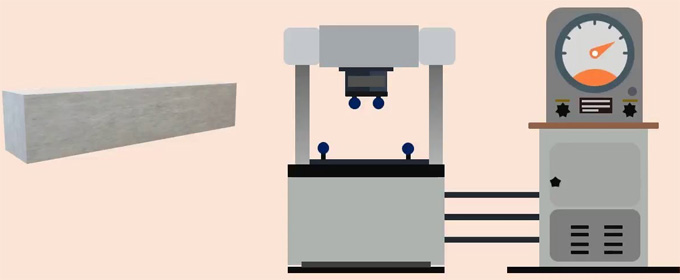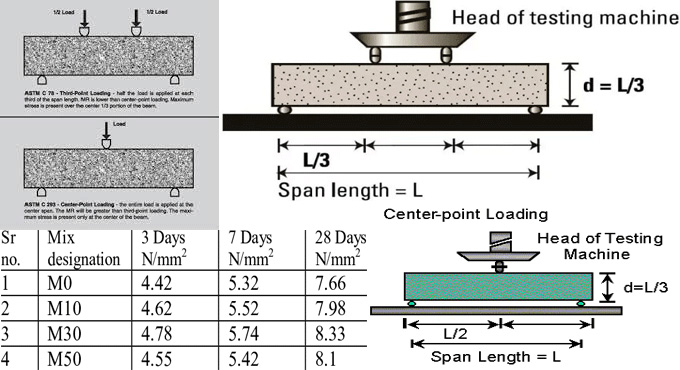
Method of Test for Flexural Strength of Concrete

The concrete flexural strength test helps to estimate the tensile strength of the unreinforced concrete. The flexural strength test of concrete determines the ability of the concrete slabs or beams to resist the bending forces.

Before applying the concrete in different construction projects, the flexural strength test of the concrete has been performed. The flexural strength of the concrete is lower than the compressive strength of the concrete, and this is because of its tendency to crack.
Equipment required for the Flexural Strength Test of Concrete
Several equipment are crucial to conduct the flexural strength test of concrete, which are as follows:
➢ In the concrete flexural strength test, a trowel is required.
➢ In the flexural strength test of concrete, the scoop is another crucial equipment.
➢ Testing machine, which is able to apply loads at a uniform rate. In this case, any kind of interruptions or shocks are not there.
➢ The material moulds have been used, which are made of iron cast or steel or any kind of nonabsorbent material. The size of these moulds should be 150 mm x 150 mm x 750 mm.
➢ Tamping rods have also been used in concrete flexural strength tests. Both large and small rods have been used in this test.
➢ A balance has been used with an accuracy of 1 g.
➢ A power-driven concrete mixture is used in the flexural strength test of concrete.
➢ The table vibration is also required while using the vibration to compact the concrete in the moulds.
Process of Concrete Flexural Strength Test
The flexural strength test of concrete has been performed in different steps, which are as follows:
➢ The concrete specimen that going to be used in the flexural strength test should be taken out immediately after the curing condition. This helps to prevent the surface drying of the concrete specimen, which reduces the flexural strength of the concrete.
➢ The concrete specimen should be placed on the loading points. It needs to be ensured that the hand-finished surface should not be connected to the loading points.
➢ In the next step, the loading system is centred in relation to the applied forces.
➢ After centring the loading system, the block applying forces has come into contact with the surface of the concrete specimen at the loading points.
➢ The 0.10 mm and 0.38 mm leaf-type feeler gages have been employed. In the case that there is any space between the concrete specimen and the load-applying blocks is present, it should be specified.
➢ Any gap that is greater than 0.10 mm should be eliminated with the help of the leather shims.
➢ In the case of the gap is greater than 0.38 mm, the grinding or capping should be followed.
➢ In the next step, the concrete specimen was loaded at a constant rate without any shock till the point of failure. In this context, the loading rate should be based on the ASTM standards. After that, the loading rate should be estimated.
➢ In the next step, the cross-section of the test concrete specimen was measured. This process helps to get the average depth and height.
Different factors that influence the Concrete Flexural Strength Test
There are different factors which bring variability in the results of the flexural strength test of the concrete. These factors include:
➢ The preparation of the concrete specimen influences the results of the concrete flexural strength test.
➢ The specimen size of the concrete affects the results of the flexural strength test of concrete.
➢ The moisture content within the concrete specimen can also bring variability in the outcomes of the flexural strength test of the concrete.
➢ The curing procedure of the concrete specimen also affects the results of the flexural strength test of the concrete.
Discuss different applications of the Concrete Flexural Strength Test
There are several applications of the concrete flexural strength test, which are:
➢ The flexural strength test of concrete is crucial in the case of designing the concrete mix.
➢ For testing the concrete which has been used in the pavement or slab construction process, the flexural strength test of concrete has been conducted.
➢ The concrete flexural strength test is also important to specify the compliances along with the standards.
Process of enhancing the flexural strength of concrete
The bond strength between the cement matrix and aggregates can be increased by using the crushed aggregates instead of rounded aggregates. Thus, using the crushed aggregates helps to enhance the flexural strength of the concrete.
To learn more, watch the following video tutorial.
Video Source: HIGHWAY GUIDE
In the case of using reactive aggregates, including calcareous aggregates, the excess amount of calcium hydroxide among the products of hydration reacts with these types of aggregates. This reaction helps to produce several by-products that enhance the flexural strength of the concrete. On the other hand, if a part of the cement has been replaced with the pozzolanic additives, it also helps to increase the concrete flexural strength.


